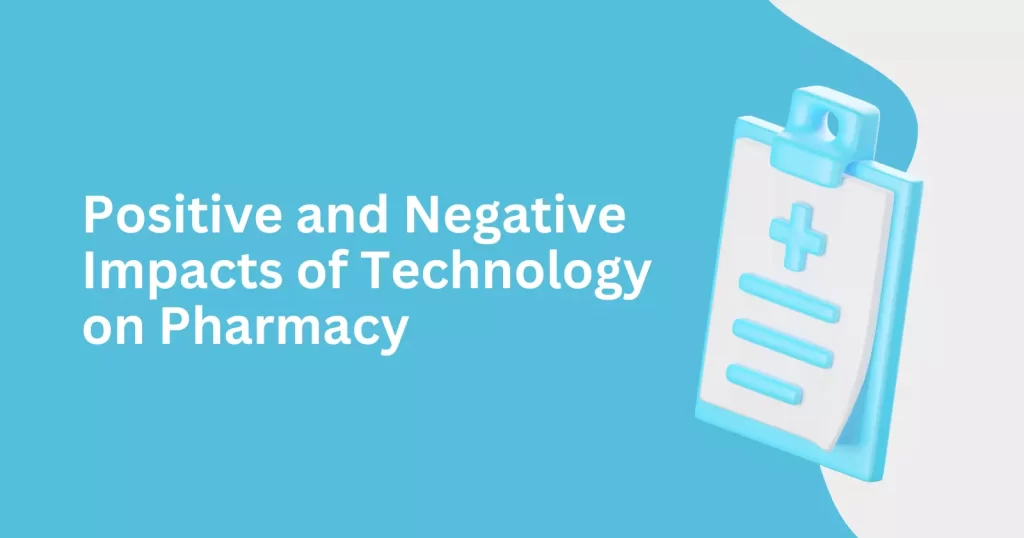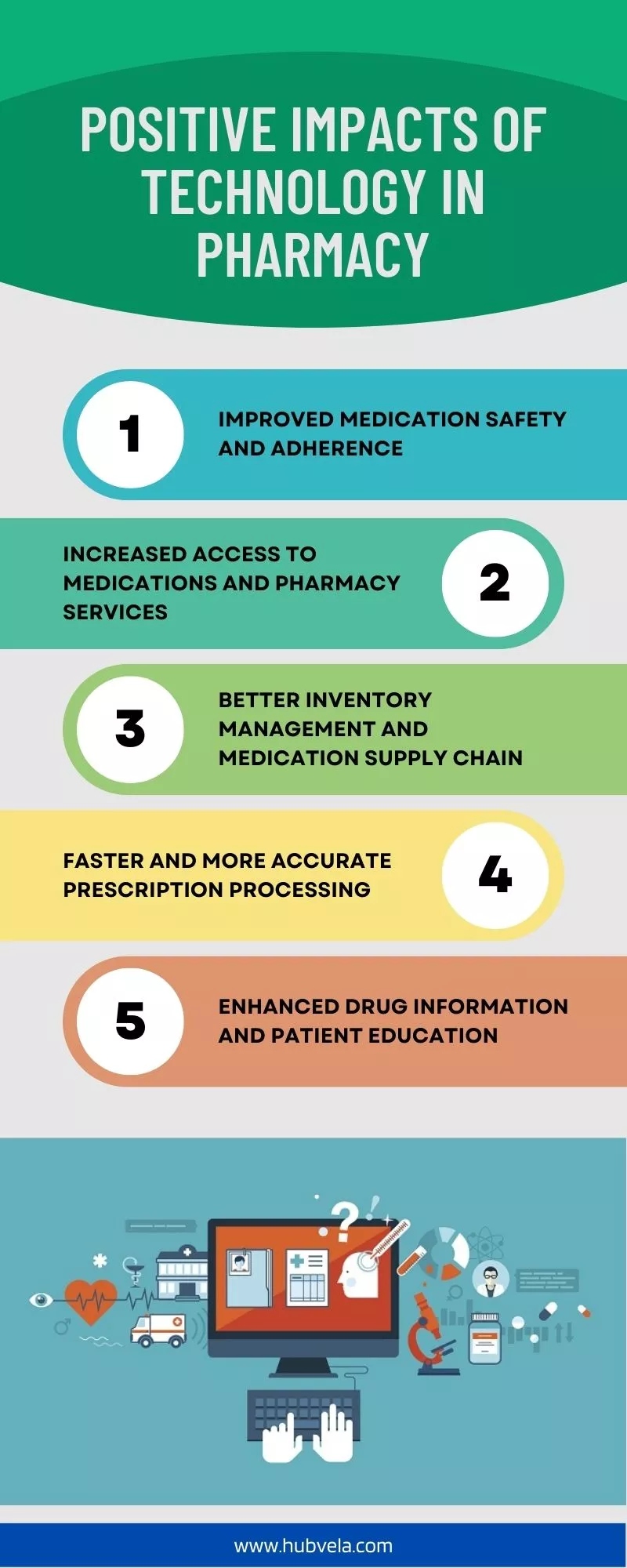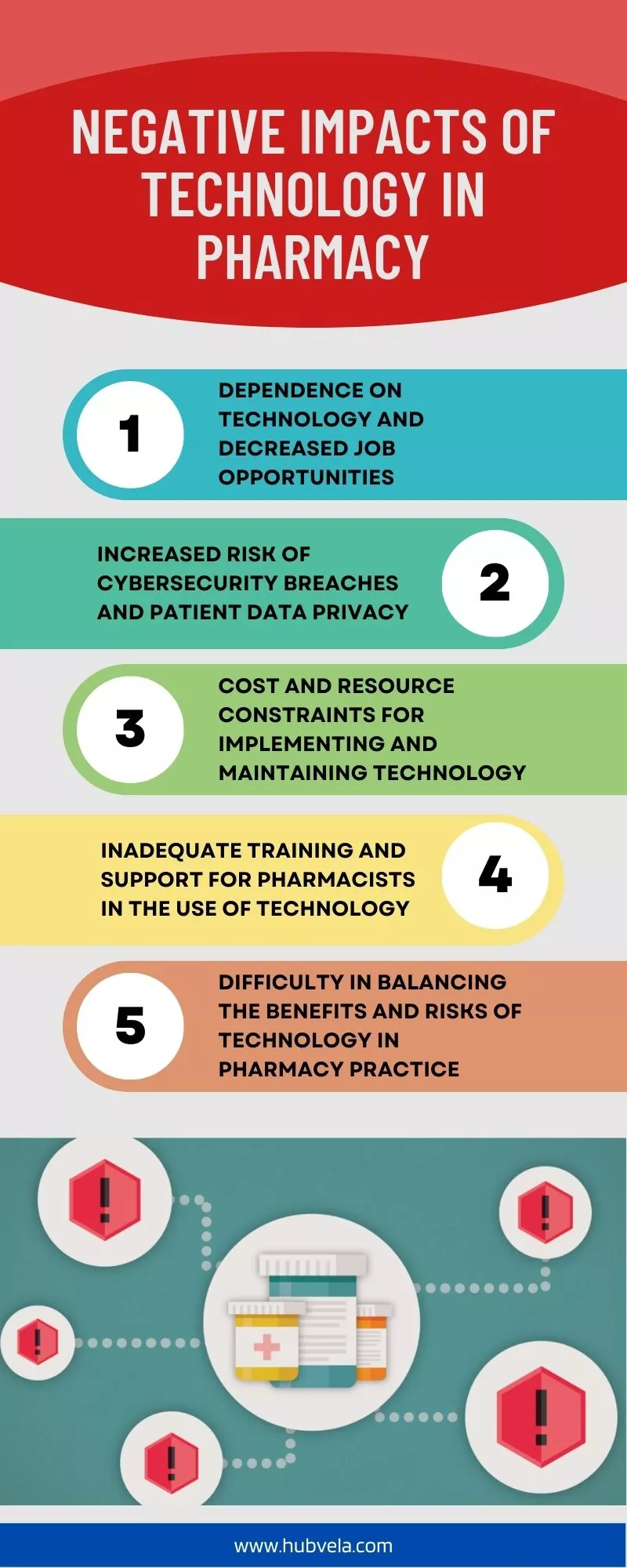The positive and negative impacts of technology on pharmacy are significant. On the positive side, technology has improved patient outcomes, reduced costs, and increased patient satisfaction.
Telecare, for example, has the potential to put patients at the center of their care, improve access to healthcare, and reduce traveling times and costs for healthcare professionals.
On the negative side, technology can cause health problems and negatively impact society in various ways.
However, the usefulness of technology in staying connected, working from home, and having access to medical services has been evident in these challenging times.
It is important to weigh the pros and cons of technology in pharmacy and use it responsibly to maximize its benefits while minimizing its negative impacts.

--Advertisement--
Positive Impacts of Technology on Pharmacy
Technology has revolutionized the healthcare industry in numerous ways, and the pharmacy sector is no exception.
From improved patient care to better resource management, technology has brought about a positive impact on the pharmacy industry.
With the help of technology, pharmacists can now stay up-to-date on drug interactions, provide better resources to their employees, and improve service to their customers.
Additionally, technology has enabled pharmacists to participate in safety improvement, which has led to better patient outcomes.
We will explore the positive impacts of technology on pharmacy.

1. Improved Medication Safety and Adherence
Technology has brought about positive impacts in pharmacies, especially in improving medication safety and adherence.
With the use of safety technology such as scanning compliance rates and alerts, pharmacists can regularly review compliance and other metric data to assess the utilization and effectiveness of the safety technology.
Additionally, interventions to improve medication adherence have been developed, including assessing and improving adherence within the context of usual clinical care, and more intensive and costly interventions that have demonstrated success.
Pharmacists can also play a role in improving medication adherence by addressing common causes of poor adherence such as inconvenience and forgetfulness and working with patients to use tools and medication dosing strategies to improve adherence.
With the expansion of pharmacists’ roles in medication therapy, patients can receive care in the home and community settings, further improving medication safety.
Overall, technology has enabled pharmacists to improve medication safety and adherence, leading to better clinical outcomes and patient satisfaction.
2. Increased Access to Medications and Pharmacy Services
Technology has revolutionized the way we access medications and pharmacy services, leading to increased convenience and improved health outcomes.
With the rise of telemedicine and online pharmacies, patients can now consult with healthcare professionals and order their medications from the comfort of their own homes.
This has been especially beneficial for those living in rural or remote areas, who may have limited access to traditional brick-and-mortar pharmacies.
In addition, technology has enabled pharmacists to better manage patient care through electronic health records and medication management systems.
This has led to improved medication adherence and reduced medication errors, ultimately resulting in better health outcomes for patients.
Overall, the increased access to medications and pharmacy services through technology has had a positive impact on healthcare, making it more accessible, convenient, and efficient for patients.
3. Better Inventory Management and Medication Supply Chain
Technology has brought about positive impacts in pharmacies, especially in inventory management and the medication supply chain.
With the use of technology, pharmacies can now manage their inventories better and address supply-and-demand challenges.
Hospitals and care providers can also benefit from technology in managing supply shortages during surges in demand.
Pharma companies can make their supply chains more resilient by embedding supply-chain risk and resilience in their strategic planning and day-to-day execution.
Furthermore, technology can strengthen the medical supply chain, ensuring that essential medications are available when needed.
Pharmacy inventory management is also made easier with technology, allowing pharmacies to keep control of inventory levels and improve their bottom line costs and profit margins.
Overall, technology has revolutionized the pharmacy industry, making it more efficient and effective in providing essential medications to patients.
4. Faster and More Accurate Prescription Processing
Technology has revolutionized the way prescriptions are processed in pharmacies, making it faster and more accurate than ever before.
With the help of electronic prescribing systems, pharmacists can now receive prescriptions directly from healthcare providers, eliminating the need for handwritten prescriptions that can be difficult to read and prone to errors.
This not only saves time but also reduces the risk of medication errors, ensuring that patients receive the right medication in the right dosage.
Additionally, technology has enabled pharmacists to access patient records and medication histories, allowing them to provide personalized care and advice.
Overall, the positive impact of technology on prescription processing in pharmacies cannot be overstated, as it has improved patient safety and outcomes while also increasing efficiency and convenience for both pharmacists and patients.
5. Enhanced Drug Information and Patient Education
Enhanced drug information and patient education are two positive impacts of technology in pharmacy.
With the help of technology, pharmacists can provide more detailed and accurate information about medications to patients.
This can include information about potential side effects, drug interactions, and proper dosages.
Additionally, technology can help pharmacists to better assess patient needs and tailor education to individual patients.
This can lead to improved medication adherence and better health outcomes.
Overall, technology has the potential to greatly enhance the role of pharmacists in patient care and improve the quality of care that patients receive.
6. Increased Automation and Efficiency in Pharmacy Operations
With the help of robotics and artificial intelligence, pharmacies can now offer more services and provide better drug safety to patients.
AI platforms can also be used to tighten inventory management, facilitate product verification, and help pharmacists perform at the top of their skill set, allowing them to focus more on high-value tasks.
Automation is already improving safety and efficiency in successful retail pharmacy operations, and technology will have an even greater impact going forward.
The pharmacy automation industry is expected to be worth $7.8 billion by 2024, with a compound annual growth rate of 8.6% from 2019-2024.
With the increasing reliability of AI, standard pharmacy operations will become increasingly automated, freeing pharmacists to focus on more complex tasks and providing better care to patients.
Overall, the use of technology in pharmacy operations is a positive development that benefits both pharmacists and patients alike.
Negative Impacts of Technology on Pharmacy
Technology has revolutionized the field of pharmacy, bringing about significant changes in the way medicines are used and patients are cared for.
While technology has brought many benefits, it has also had negative impacts on the industry.
We will explore the negative impacts of technology on pharmacy.

1. Dependence on Technology and Decreased Job Opportunities
While technology has made certain tasks easier and more efficient, it has also led to a decrease in job opportunities.
With the introduction of automated systems and machines, many pharmacy jobs that were once done manually are now being replaced by technology.
This dependence on technology has also led to a decrease in the need for human labor, resulting in job losses and increased unemployment rates.
It is important to find a balance between the use of technology and the need for human labor to ensure that the negative impacts of technology on job opportunities are minimized.
2. Increased Risk of Cybersecurity Breaches and Patient Data Privacy
Technology has also led to an increased risk of cybersecurity breaches and patient data privacy.
The sensitive electronic protected health information (ePHI) handled by clinics and hospitals is at risk of being compromised by cyberattacks.
These attacks can have a negative impact on clinical outcomes and patient safety.
In 2020, healthcare hacking attacks were particularly brutal, with data from the U.S. Department of Health and Human Services showing that almost 700 healthcare providers were affected.
It is therefore crucial for HIPAA-covered entities and business associates to prioritize cybersecurity and patient privacy to ensure the continuity of effective delivery of high-quality care and mitigate disruptions that can arise from cyberattacks.
The healthcare industry must remain vigilant and take proactive measures to address the top security concerns in the industry
3. Cost and Resource Constraints for Implementing and Maintaining Technology
Implementing and maintaining technology also comes with cost and resource constraints.
Pharmacy organizations need to consider the triple constraint of time, cost, and scope when implementing technology.
Resources such as people, equipment, materials, facilities, and software are required for technology implementation and maintenance, and without proper resource allocation, the project may experience lower quality, increased budget, and timeline delays.
Resource constraints can disrupt the project and impede effective delivery, so it is important to identify and manage them during the project planning process.
The amount of money available for the project regulates the availability of supplies and the amount and expertise of human capital that the company can access.
Pharmacy organizations need to identify, resolve, and overcome resource constraints to ensure the successful implementation and maintenance of technology.
4. Inadequate Training and Support for Pharmacists in the Use of Technology
The rapid advancement of technology has brought about significant changes in the field of pharmacy.
While technology has the potential to improve patient care and streamline processes, inadequate training and support for pharmacists in the use of technology can have negative impacts.
One of the major negative impacts of technology in pharmacy is the potential for medication errors.
Without proper training and support, pharmacists may struggle to navigate complex electronic health records and medication dispensing systems, leading to errors in medication dosage or administration.
In addition, inadequate training and support can lead to decreased efficiency and productivity.
Pharmacists may spend more time troubleshooting technology issues than providing patient care, leading to longer wait times and decreased patient satisfaction.
Furthermore, the lack of training and support can lead to frustration and burnout among pharmacists.
The stress of navigating unfamiliar technology can take a toll on mental health and lead to high turnover rates in the profession.
It is crucial that pharmacists receive adequate training and support in the use of technology to ensure that the potential benefits of technology are realized and the negative impacts are minimized.
This can be achieved through ongoing education and training programs, as well as providing access to technical support and resources.
5. Difficulty in Balancing the Benefits and Risks of Technology in Pharmacy Practice
Technology has brought about negative impacts such as medication errors due to system glitches and lack of human intervention.
The challenge lies in balancing the benefits and risks of technology in pharmacy practice.
Pharmacists must be cautious in relying solely on technology as a total solution, as it may have consequences that were unanticipated.
It is important to recognize that technology should be used as a tool to improve pharmacy practice, but not as a replacement for human intervention.
As technology continues to evolve, pharmacists must adapt and find ways to integrate it into their practice while ensuring patient safety and well-being.
Conclusion on the Positive and Negative Impacts of Technology on Pharmacy
In conclusion, technology has brought about significant changes in the field of pharmacy. It has revolutionized the way we diagnose, treat, and manage diseases.
The positive impacts of technology on pharmacy include improved patient outcomes, increased efficiency, and reduced medication errors.
However, there are also negative impacts such as the potential for technology to be misused, leading to privacy breaches and medication errors.
It is important to use technology in a responsible and disciplined way to maximize its benefits while minimizing its negative impacts.
As technology continues to evolve, it is crucial for pharmacists to stay up-to-date with the latest advancements and use them to provide the best possible care for their patients.


